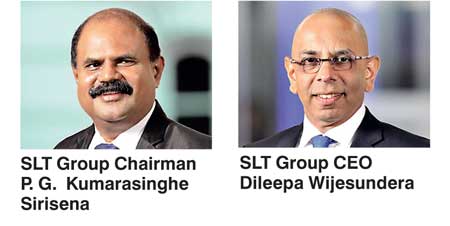Saturday Jan 04, 2025
Saturday Jan 04, 2025
Thursday, 17 August 2017 00:27 - - {{hitsCtrl.values.hits}}
 The Sri Lanka Telecom (SLT) Group released its group and holding company financial performance results for the six months ending 30 June 2017 yesterday reporting a 2% growth reaching Rs.37.4 billion when compared with the previous year.
The Sri Lanka Telecom (SLT) Group released its group and holding company financial performance results for the six months ending 30 June 2017 yesterday reporting a 2% growth reaching Rs.37.4 billion when compared with the previous year.
The group comprises eight subsidiaries, including the mobile arm Mobitel Ltd.
During the six months ending 30 June, the group reported Rs. 37.4 billion in revenue with a 2% year-on-year growth, while maintaining a nominal growth of 1% in operating costs. Group Earnings Before Interest, Tax, Depreciation and Amortization (EBITDA) was reported at Rs. 11 billion.
This was a 4% increase compared to the same period last year. The EBITDA margin remained at 29%.
As a result of the continuous expansions, the group depreciation and amortization was recorded at Rs. 8.2 billion, which is a 20% year-on-year increase. This increase was mainly driven by the investments of the holding company on new technologies and customer base expansion initiatives. The decrease in group profits reflected the increase in depreciation due to high investment in infrastructure.
The holding company Sri Lanka Telecom (Plc), recorded Rs. 22.1 billion in revenue during the six months ending 30 June 2017, with a 4% increase compared to the same period last year, while managing operating costs at Rs. 16.3 billion, with only a 1% year-on-year increase.
Group Chairman Kumarasinghe Sirisena stated that the new Group Strategic Directional Plan will drive each segment of the group together to boost market leadership, whilst enhancing corporate values utilising group strengths. He said that the group would continue to simplify and streamline the business and rationalise costs as demonstrated by the ongoing performance transformation activities.
Group Chief Executive Officer Dileepa Wijesundera expressed his confidence in achieving better returns through continuous investments in expansions and technological improvements. He stated that initiatives have also been taken to control costs and drive sales. These initiatives he believes will significantly enhance the company’s performance in the coming months.
Key developments in the strategic initiatives of the group included strengthening of the National Backbone Network - SLT raised its concerns with Telecom Regulatory Commission (TRCSL) over the ROI on NBN and continuous lobbying with authorities against license violation.
Raising concerns on spectrum issues – SLT continuously lobbied the authorities for allocating spectrum to accelerate fixed and mobile LTE rollout. Strengthening Next Generation Broadband – This initiative improves geographical coverage, speed, volumes and ARPU of broadband products, catering to the growing demand for robust fixed broadband by further expanding fibre to homes/premises (FTTH/P) up to 100 Mbps speed and 4G/LTE expansion as swell.
SLT also became the first Telco to successfully field test Pre-5G LTE Advanced Pro Technology in South Asia, achieving 855.9 Mbps user throughput achieved using Advanced Carrier Aggregation in TD-LTE 2500 MHz band and over 700 Mbps cell throughput achieved on a single TDD Carrier using Massive MIMO and 5.5 millisecond user plane latency showcased.
The company will also be launching its newly-built state-of-the-art Tier 3 Internet Data Centre in Pitipana-Homagama and officially commence SEA-ME-WE 5 -undersea cable system, with a newly-established cable landing station in Matara within the third quarter.
SLT’s new data centre will be the country’s first purpose-built tier 3 data centre and will enhance the provision of a secure and reliable data hosting facility and Cloud computing services to Sri Lankan businesses. With the advent of the SEA-ME-WE 5 cable system and landing station, Sri Lanka is perfectly positioned to place itself as a regional digital hub.
SLT is also committed to further oversee South Asia’s first cutting-edge submarine cable depot at the Galle Port in the South of the country. This cable maintenance station will oversee the repairing of all cables in the region, even those pertaining to external telecommunication operators.
SLT also provided a global connectivity backhauling facility to international operators. This network consists of three cable stations situated in Colombo, Mount Lavinia and Matara joined to the international backhaul hub in Welikada. This will help establish Sri Lanka as a regional digital hub and add the country to the International PoP network.